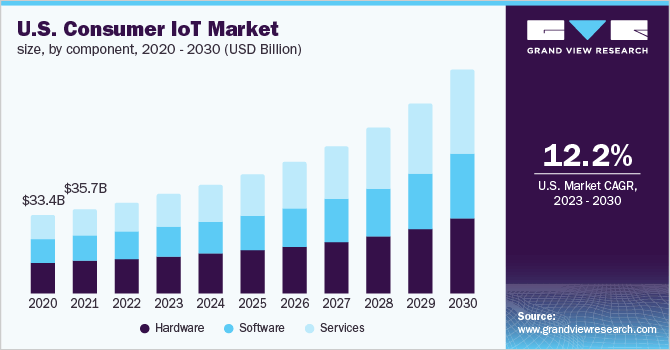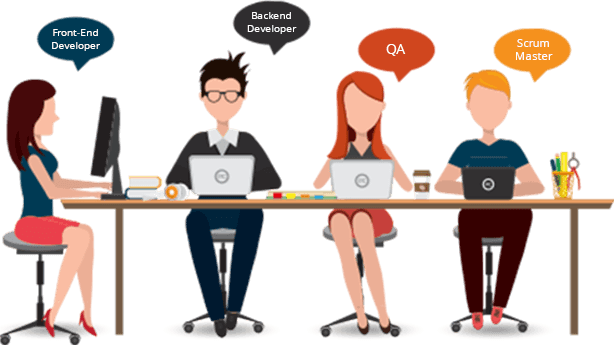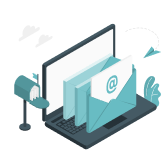IoT app development cost: exploring 5 factors that influence

In today’s digital world, IoT capabilities open new horizons for innovative solutions that connect people with technology. Traditionally, new opportunities are often coupled with challenges. One of the biggest challenges is determining the cost required to implement an IoT product idea. In this article, we’ll explore the key costs involved in IoT app development, the factors that impact it, and ways to reduce the costs.
The total cost of an IoT application in the current market: overview
The IoT integration market is projected to increase from USD 3.2 billion in 2023 to USD 12.1 billion by 2028, with a CAGR of 30.8%. The market is driven by the growth of IoT devices in various industries. The companies are interested in data collection to use the information for enhancing operational efficiency, reducing downtime, and making informed decisions.
The requirement for IoT will also grow due to upcoming smart cities. IoT development is expected to be driven by smart city initiatives, with infrastructure, utilities, and transportation projected to use more IoT devices. Government initiatives will increase IoT usage, leading businesses to rely more on professional services that deploy IoT apps.
As for the consumer IoT market, it’s expected to grow at a CAGR of 12.7% from 2023 to 2030. This growth is due to the increasing popularity of advanced devices and home appliances. Consumer IoT devices are integrated with microcontrollers and wireless technologies, making data management easier. The devices include smartphones, wearables, and smart home devices.

How is IoT impacting application development?
The integration of IoT technology in application development paves the way for new interconnected solutions, yet it also creates some challenges. Let’s review some factors that require your attention when starting a project in the IoT industry.
The high diversity of devices, technologies, operating systems, and communication protocols requires developers to customize the apps to function seamlessly across multiple devices and often integrate their software with the existing systems. As a result, engineers need to develop custom APIs, drivers, firmware, or middleware to meet the needs.
IoT applications generate large volumes of data from the devices. To extract valuable insights and make informed decisions, developers need to design applications with efficient data processing to collect and analyze the data in real time.
IoT devices are often prone to security risks due to decentralized communication and limited computing resources. To protect sensitive data and prevent unauthorized access to IoT networks, developers must implement strong security measures such as encryption, access control, and authentication.
A growing trend in IoT is edge computing: processing data at the network’s edge, closer to its source, instead of relying solely on centralized cloud servers. This approach minimizes latency, conserves bandwidth, and enhances privacy. Developers must adapt their applications to support edge computing architectures and optimize performance for distributed environments.
IoT applications interact with users through various interfaces, such as mobile apps, web portals, and voice assistants. To enable seamless user experience across different devices and platforms, developers must prioritize user experience design. They need to ensure that these interfaces are intuitive, responsive, and accessible.
5 factors that affect IoT app development cost
So, what actually affects the IoT app development cost? Based on our experience, we’ve collected several aspects you may want to consider before starting the development process.
1. IoT backend & infrastructure
Any IoT system needs a back-end to process the sensor data collected from the connected devices. There are two options in terms of infrastructure: build a web server from scratch or buy a ready-made cloud solution. The choice will directly affect the IoT cost: choosing a ready-made solution is more cost-effective than building a web server from scratch.
It’s also worth mentioning that the off-the-shelf solution won’t work completely independently: you will still need backend specialists to support the system and implement the proper security measures. In most cases, however, it will still be a more optimized solution for saving costs.
In most cases, companies choose servers by Amazon or Google to store the IoT data. This way, they can add new smart devices later or scale down once it is needed. One also has to pay monthly subscription fees for using these services rather than make a one-time investment.

2. IoT app development
The term “IoT app” usually implies a wide range of applications that enable end-users to interact with IoT systems, adjust their settings, and interpret sensor data. Let’s mention some factors that affect the IoT app development cost.
Functionality
1. Think of the core features
First, think about the user’s needs you would like to cover with your product. Then imagine why the user would want to get your app, how they will use it, and how you can serve their needs best. For example, a map displaying the equipment movement in real-time is crucial for a traffic management app. Any basic features should be implemented in the software, regardless of their quantity and complexity. This basis would make up your product’s value proposition, so don’t underestimate the functionality.
2. Avoid unnecessary features
At the beginning of the project, don’t focus on non-priority, excessive, or unreasonable bells and whistles that can overwhelm your users and increase the IoT development cost. Your project shouldn’t include anything randomly picked up from rivals if it doesn’t fit into the concept of your product. What worked well for one company may not work as well for another. Instead, focus on creating a functional yet simple IoT app. Think about the user interface: it should be neat and serve users well. You can implement additional features later on as updates or premium options.
3. Set your differentiative points
There’s an exception for the previous factor. If a non-crucial feature is something that will make your whole IoT solution stand out and you are planning to use it for promotion, include it as a basic necessity. Say, a 3D map of a construction site may seem excessive in terms of saving costs, but if it’s your strong suit, go for it instead of a 2D map or another simple solution.
Target OS
Think of all the operating systems where your IoT app should run. There are several options to choose from:
Native apps for each platform
Cross-platform app for running on multiple platforms
Web or hybrid apps
While cross-platform and web frameworks save the time & costs spent on development, they also add restrictions to creating native features. Thus, if you want to target mobile, web, and desktop OS with the same app, add the cost of IoT development for each target platform.
Choosing the technology stack for your IoT solutions may be a tricky question, so it’s better to consult your IoT app developers to choose the most appropriate IoT platforms and technologies.
3. IoT hardware cost
IoT hardware refers to the physical components and devices that facilitate connectivity, including IoT sensors, computer chips, cables, actuators, and smart devices like tablets. In some cases, up to 70-80% of total IoT project costs might go to hardware development alone. If you want to reduce expenses, consult with your IoT partner about the components and design of your IoT solution.
Another hardware expenditure item is the certification of your device. In many cases, IoT device certifications are obligatory to prove that the device fits the required standards. This stage might consume a large part of your budget, depending on the industry, the complexity of the product, the need for testing, whether it’s for the domestic or international market, etc.
It’s a good idea to obtain quotes from multiple certification agencies to compare costs. This will help you get a better understanding of the average cost range for your specific product and choose the best option.
4. IoT development team size & time
The scope & structure of your team will directly affect your IoT development budget. A full-scale IoT development team consists of
System architect
Hardware engineer
Firmware or embedded software engineers
Back end developer
Front end developer
Mobile app developer
UX/UI designer
Project manager
QA engineer
DevOps
No doubt, such a team will require a great deal of investment. However, the optimal structure and number of specialists differ significantly from case to case. For instance, you might need a hardware developer for the beginning of your project. If you have the product design ready, UI/UX designers won’t be needed as well. From our experience, it takes around $40K/month to handle a team of 10 members. However, the rates vary a lot across the countries and even cities.

5. Hidden & unpredicted costs
Any changes to functionality or design along the project add more man-hours of work and end up changing the whole game. That’s why it’s worth including the unpredicted expenses in your budget. Make sure you have a clear product vision to prevent any further redesign or redevelopment tasks. A common rule of thumb is to set aside around 10% to 20% of the total cost of IoT solution for contingency purposes.
How to reduce IoT development costs?
There are several aspects that you may want to consider to reduce the cost of IoT application development.
Start with discovery phase
The discovery phase will help you establish a solid business case for your solution and ensure there are no technical roadblocks ahead. This may cost you around $10,000-12,000, still this is a small price to pay compared to the potential losses you may face if you have to abandon the entire project midway.
Create an MVP
The minimum viable product features enough functionalities that help attract early adopter customers and validate a product idea during the early stages of product development. In terms of IoT application development, an MVP can help the product team quickly receive user feedback to make some adjustments or improvements before mass production.
Use out-of-the-box components where possible
Consider leveraging off-the-shelf hardware components, IoT platforms, or cloud solutions instead of building everything from scratch. This approach can significantly reduce development time and costs for wireless connectivity, data processing, device management, etc.
Use open-source software
Open-source frameworks often offer sufficient functionality and are a cost-effective alternative to their proprietary counterparts. Platforms like Raspberry Pi and Arduino can be chosen for hardware development, while platforms like Eclipse IoT and ThingsBoard offer open-source middleware for IoT application development.
Adopt modular design
This allows engineers to reuse components across different IoT projects. Modular architectures reduce duplication of effort, minimizing the time and resources required to develop and maintain IoT solutions. They also allow for a higher flexibility of the project.
Leverage cloud services
In terms of hosting, data storage, and analytics there are a bunch of options to choose from. Cloud providers offer pay-as-you-go pricing models that scale with usage, eliminating the need for large upfront investments in infrastructure. Additionally, cloud services often include built-in support for IoT-specific functionalities such as device management, data processing, and security.
Outsource software development
If you don’t have an in-house team of engineers, outsourcing may save you a great deal of money and time. If you do have some developers but miss some specific skills, augment your team with third-party developers. Software development companies usually offer flexible cooperation models so you can just hire the needed talent to complement your team.
Optimize resource usage
For in-house engineering, develop efficient code and optimize resource usage to minimize hardware requirements and energy consumption. Code optimization, data compression, and power management can help reduce the overall cost of IoT solutions by lowering hardware costs and operational expenses. If you outsource software development, inquire about your tech partner’s optimization strategies and techniques.
Out-of-the-box app vs custom IoT app: Which will be best?
If you’re planning to create a custom IoT ecosystem or new electronic device, you will most likely need to create at least a custom design, firmware, and software. While you can use some ready-made hardware, sensors, and infrastructure solutions, you will hardly find a relevant software solution to work with it.
Speaking of ready-made vs custom components for your project is another good question, so let’s take a look at some advantages and challenges of both custom and out-of-the-box solutions.
Out-of-the-box solution features
Lower upfront costs. If you have budget constraints or need to minimize the initial investment, the ready-made solutions would be a better choice.
Faster deployment. The off-the-shelf components allow for faster start. If this is your priority, use the out-of-the-box solutions where possible. Be careful, as some third-party components may have integration issues later on.
Standardized features. Out-of-the-box solutions often come with standard features and functionalities that cater to common IoT use cases. While this can be convenient, it may limit flexibility if you require highly customized or specialized functionalities.
Limited customization. The extent to which you can tailor the off-the-shelf solution to your specific needs may be limited. If your requirements are highly unique or complex, you may find that this solution does not fully meet your needs.
Vendor support. Out-of-the-box applications are typically supported by the vendor who developed them, which can be advantageous in terms of ongoing maintenance, updates, and technical support. However, the level and quality of support may vary depending on the vendor.
Custom solution features
Tailored to your needs from the very beginning. Custom solutions are developed specifically to meet your unique requirements, offering a high degree of customization and flexibility. The pitfall here is that at the beginning of the project, you may not be able to identify the exact needs accurately.
Scalability. Custom development can be designed to scale with your business as it grows. The developers who are aware of the future scaling requirement will build the appropriate architecture from the ground up so that when the project grows, the software will seamlessly grow with it.
Competitive advantage. A custom IoT application will anyway be different from the competitors, enabling unique features or functionalities that are not available in off-the-shelf solutions.
Total ownership. With a custom IoT application, you have full ownership and control over the software, including the underlying codebase and intellectual property. This can provide greater flexibility and independence compared to relying on third-party vendors for ongoing support and updates.
Higher upfront cost and slower deployment. Custom development typically involves higher upfront costs compared to purchasing an off-the-shelf solution. It also requires more time to be designed, developed, and tested.
Conclusion
There are a lot of factors that affect the price of IoT development and they may differ significantly from case to case. As the price of IoT sensors is dropping, connected gadgets are becoming more accessible to users and the requirement for IoT is growing with time. To find out the exact price of IoT system development, contact us and learn how expensive or cheap your IoT system is to create.
Frequently Asked Questions
How to develop an IoT app?
1. Define your project goals.
2. Identify the hardware you’ll need.
3. Select an appropriate communication protocol.
4. Design a user-friendly interface.
5. Develop the backend infrastructure to collect, process, and analyze data from connected devices.
6. Test your app considering security.
7. Deploy your app to users.
Alternatively, delegate the development process to a third-party software development company.
How much does IoT cost?
The average IoT cost estimate can range between $10,000 and $50,000, yet there are projects priced at $5,000 to $100,000+. The price highly depends on the complexity of the solution, industry, development method, hardware, infrastructure, need for testing and certification, and other factors.
What are the main factors affecting the IoT application development cost?
The main factors are hardware and software costs, while software costs include IoT backend and infrastructure, development team size, target OS, functionality, and complexity of the software. Hardware costs include costs for device enclosure, testing and certification if required.
Can we reduce the cost of our IoT application?
There are some strategies to reduce IoT costs. They include outsourcing development, using off-the-shelf components, and implementing best development practices.




